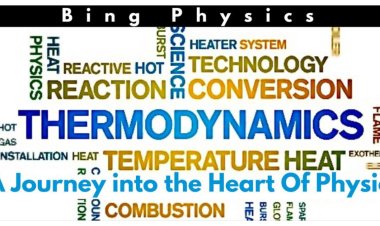Unveiling the Marvels of Thermodynamics: A Journey into the Heart of Physics
The world of physics is a captivating realm where the laws of nature govern everything from the tiniest particles to the vast expanses of the universe. Among the fundamental branches of physics, thermodynamics stands out as a pillar, providing insights into the behavior of energy and matter. In this blog, we embark on a fascinating journey into the realm of thermodynamics, exploring its principles, applications, and the wonders it unveils about the physical world.
Understanding the Basics: What is Thermodynamics?
At its core, thermodynamics is the study of energy and its transformations. It deals with the principles governing heat, work, temperature, and energy transfer. The laws of thermodynamics are fundamental to our understanding of the universe, dictating the behavior of everything from steam engines to black holes.
—
The Four Laws of Thermodynamics
1. Zeroth Law:
If two systems are each in thermal equilibrium with a third system, they are in thermal equilibrium with each other. This seemingly simple law forms the basis for temperature measurement.
2. First Law (Conservation of Energy):
Energy cannot be created or destroyed, only converted from one form to another. This law is the foundation for understanding heat and work interactions in various processes.
3. Second Law (Law of Entropy):
In any energy transfer or transformation, the total entropy (a measure of disorder) of a closed system will never decrease over time. This law explains the direction of natural processes and the irreversibility of certain phenomena.
4. Third Law:
As the temperature of a system approaches absolute zero (0 Kelvin or -273.15°C), the entropy of the system approaches a constant minimum. This law sets a limit on how efficiently a process can be performed.
Applications of Thermodynamics
1. Heat Engines:
Thermodynamics powers engines that propel our cars, trains, and planes. The efficiency of these engines is dictated by thermodynamic principles.
2. **Refrigeration and Air Conditioning:**
Thermodynamics enables the design of refrigeration systems, keeping our food fresh and our living spaces comfortable.
3. **Thermal Power Plants:**
The generation of electricity in thermal power plants relies on converting heat energy into mechanical energy, a process deeply rooted in thermodynamics.
4. **Chemical Reactions:**
Thermodynamics plays a crucial role in understanding and predicting chemical reactions, guiding processes in chemical industries.
—
**Beyond the Everyday: Advanced Concepts in Thermodynamics**
1. **Statistical Thermodynamics:**
At the microscopic level, thermodynamics finds its explanation in the behavior of individual particles. Statistical thermodynamics bridges the macroscopic laws of thermodynamics with the microscopic world of particles and probabilities.
2. **Thermodynamics in Astrophysics:**
Thermodynamics helps us comprehend the extreme conditions in the universe, from the nuclear fusion in stars to the behavior of matter near black holes.
—
**Conclusion**
In the vast tapestry of physics, thermodynamics stands as a testament to the intricate balance of energy and matter. Its laws shape our understanding of the physical world and underpin technologies that drive our modern lives. As we delve deeper into the mysteries of the universe, the principles of thermodynamics continue to guide our exploration, revealing the secrets of energy, heat, and entropy. Through its profound insights, thermodynamics exemplifies the beauty of scientific inquiry, showcasing the elegance with which nature orchestrates the dance of particles and energy in the cosmos.
—
*Note: This blog provides a concise overview of thermodynamics, touching on its fundamental principles, applications, and advanced concepts. For a deeper understanding of specific topics within thermodynamics, further exploration and study are encouraged.*
